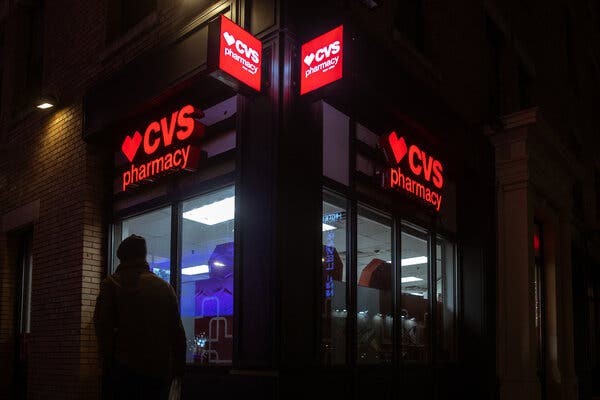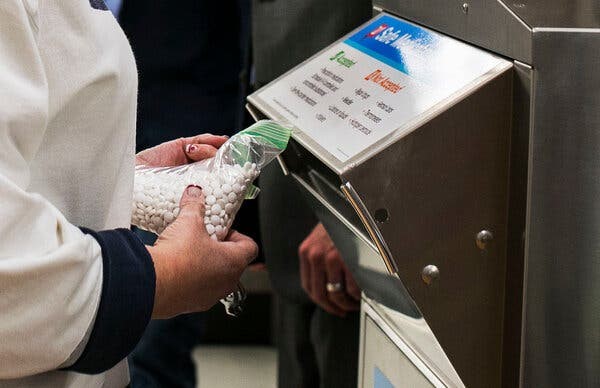W. Mark Lanier: CVS, Walgreens and Walmart Perpetuated Opioid Crisis, Jury Finds
The New York Times, By Jan Hoffman, Nov. 23, 2021Updated 3:00 p.m. ET
This is the first jury verdict in an opioids case. The decision embraced a key legal argument that judges in other opioids cases had recently rejected.

Plaintiffs argued that pharmaceutical companies abetted or deliberately ignored the oversupply of opioids and their subsequent diversion, jeopardizing public health and safety.Credit...Jeenah Moon for The New York Times
In a closely watched test case, a federal jury in Cleveland on Tuesday found that three of the nation’s largest pharmacy chains, CVS Health, Walmart and Walgreens, substantially contributed to the crisis of opioid overdoses and deaths in two Ohio counties, the first time the retail segment of the drug industry has been held accountable in the decades-long epidemic.
The trial judge will determine how much each company should pay the counties, after as yet unscheduled hearings. New federal data released last week show overdose deaths from illegal opioids such as heroin and street fentanyl have reached record levels during the pandemic.
The verdict — the first from a jury in an opioids case — was encouraging to plaintiffs in thousands of lawsuits nationwide who are relying on the same legal strategy employed in this case, namely that pharmaceutical companies contributed to a “public nuisance” — a legal hurdle that plaintiffs contend covers the public health crisis created by opioids.
“For decades, pharmacy chains have watched as the pills flowing out of their doors cause harm and failed to take action as required by law,” the lawyers for the two counties along with attorneys for local governments across the country said in a statement after the verdict.
“The judgment today against Walmart, Walgreens and CVS represents the overdue reckoning for their complicity in creating a public nuisance,” the statement continued.
The public nuisance argument was rejected twice earlier this month, by judges in California and Oklahoma in separate cases against opioid manufacturers. The judges ruled that the companies’ activities were too removed from the overdoses and deaths, and that this application of public nuisance law had been stretched beyond recognition.
But in this case, brought by Lake and Trumbull counties in northeastern Ohio, lawyers for the plaintiffs used the legal theory successfully. They argued that for years, the pharmacies turned a blind eye to countless red flags about suspicious opioid orders, both at the local counter with patients and at corporate headquarters, whose oversight requirements were, according to Mark Lanier, the counties’ lead trial lawyer, “Too little, too late.”
The 12-member jury deliberated for five-and-a-half days, after a six-week trial.
The deep-pocketed retailers were the last cluster of pharmaceutical corporations to be pursued in the courts and the most resistant to negotiating broad settlements. To date, they have faced fewer lawsuits than other pharmaceutical companies.
This past summer, Walgreens, Rite Aid, CVS Health and Walmart settled with two New York counties, Nassau and Suffolk, for a combined $26 million. In the Ohio case, Rite Aid and Giant Eagle, a regional chain, settled earlier for undisclosed sums.
In contrast, various opioid manufacturers and distributors have committed billions of dollars in settlement offers, some nationwide.
CVS and Walgreens immediately said they would appeal the verdict, and Walmart is expected to do the same. “Pharmacists fill legal prescriptions written by D.E.A.-licensed doctors who prescribe legal, F.D.A.-approved substances to treat actual patients in need,” the company said in a statement.
The statement continued: “We look forward to the appeals court review of this case, including the misapplication of public nuisance law. ”
In closing arguments at the Cleveland trial in U.S. District Court last week, Mr. Lanier, a Texas trial lawyer who represented the counties, said the pharmacy chains are “making money off every pill they sell. They don’t make money off a refusal to fill.”
Mr. Lanier, who has made a career out of wresting eye-popping awards from Big Pharma, told the jury that the corporate entities should have been on notice as far back as 2012, when the Drug Enforcement Administration began pursuing Florida chain pharmacies for pumping out opioids that landed as far away as Ohio.
The jury had to first decide whether the oversupply of prescription pills and subsequent illegal diversion created a public nuisance in each county.
Under the public nuisance law, a crisis must be continuing. But in recent years, the number of opioid prescriptions has dropped off, largely because of greater oversight by state and federal monitoring programs, revised guidelines for doctors and corporate compliance.
The counties’ lawyers successfully argued that when the supply receded, patients who were addicted turned to heroin and illegal fentanyl use. That result was a foreseeable, direct descendant of the floods of prescription opioid pills, the lawyers said.
After jurors concluded that a “public nuisance” did exist related to the opioid crisis in the counties, they moved on to a second question. Did each pharmacy chain engage in conduct that was “intentional” or “illegal,” substantially contributing to the public nuisance of the opioid crisis?
If so, under the law, defendants must pay to “abate” the “nuisance” that they exacerbated.
Like jury decisions in criminal cases, the verdict in this civil case had to be unanimous. But the jury only needed to apply “the greater weight of evidence” (at least 51 percent) as a standard of proof, which is lower than the level of “beyond a reasonable doubt” required to render a guilty verdict in criminal trials.
The pharmacy lawyers responded with arguments that appeals courts might yet find persuasive. The number of their stores amounted to a fraction of the pharmacies, hospitals and clinics that dispense opioids in the two counties, they said, and the quantity of pills they prescribed was commensurately low. Law enforcement officials, who arrested the owner of an independent county pharmacy for dispensing egregious quantities of high-dose opioids, never cited any of the counties’ chain pharmacies.

A safe medication disposal box at Walgreens Pharmacy in Claremore, Okla.Credit...Ruth Fremson/The New York Times
There were far too many reasons that opioid medications exploded across the counties to lay the blame so resoundingly at the feet of the pharmacies, their lawyers contended. They pointed to family medicine cabinets, the repository of so many unused pills, as troves for illegal diversion; to drug cartels; to manufacturers, who solicited doctors and oversold the benefits of opioids and downplayed the risks; and to doctors who, urged to treat pain more aggressively, increasingly ordered larger and more potent quantities.
“We all know that it’s the prescribers who control demand,” said Brian Swanson, a lawyer for Walgreens. “Pharmacists don’t create demand.”
Repeatedly, the defendants’ lawyers pointed the finger at federal authorities. Not only were the drugs approved by the Food and Drug Administration, they said, but the D.E.A. also bore responsibility for the huge quantities. Federal regulators set the annual limit on how many opioids could be produced in the country, which, through 2012, they kept raising.
In his final remarks, Mr. Lanier acknowledged that there were many contributors to the crisis. But pharmacies could not escape responsibility, he argued, by saying they only put relatively small quantities of opioids into the counties (and he disputed the defense’s method of calculation).
He then produced a model bridge made of hundreds of Legos, to echo a bridge over the Cuyahoga River that can be seen from the courthouse.
The community relies on the sturdiness of the bridge’s steel trestles, he said.
But what if two or three are rotten or in the wrong place as people are driving over it? he asked, knocking out just a few. “Everything can fall,” he said, as the model shattered in front of the jury.
Whether this verdict will survive on appeal remains to be seen. In addition to the many legal questions arising from the case, defendants are expected to continue their criticism of Judge Dan Aaron Polster, who presided over the trial and has, for years, supervised the aggregation of thousands of opioid lawsuits.
The statement from Walgreens seemed to forecast as much: “We believe the trial court committed significant legal errors in allowing the case to go before a jury on a flawed legal theory that is inconsistent with Ohio law,” it said. “As we have said throughout this process, we never manufactured or marketed opioids nor did we distribute them to the “pill mills” and internet pharmacies that fueled this crisis. The plaintiffs’ attempt to resolve the opioid crisis with an unprecedented expansion of public nuisance law is misguided and unsustainable.”
A dispute over whether a mistrial should have been declared could be among the arguments for appeal: A juror showed other jurors her outside research (the juror was dismissed and the trial continued). And the pharmacy retailers will likely resurrect their longstanding complaint — that Judge Polster appeared to favor plaintiffs, because from the outset he has urged all sides to settle so that desperately needed relief can start flowing to counties trying to rebuild their ravaged addiction treatment programs and foster care services.




